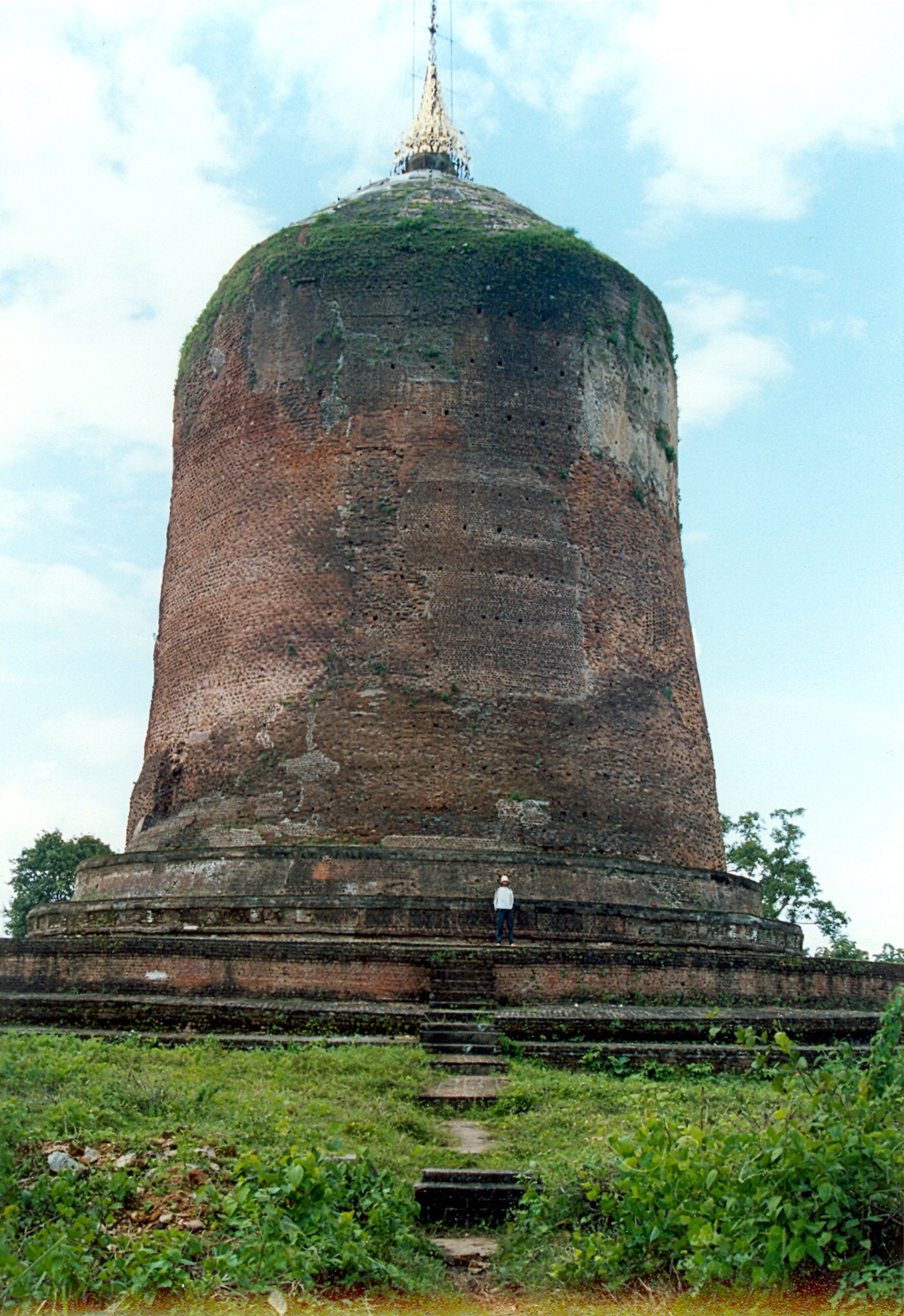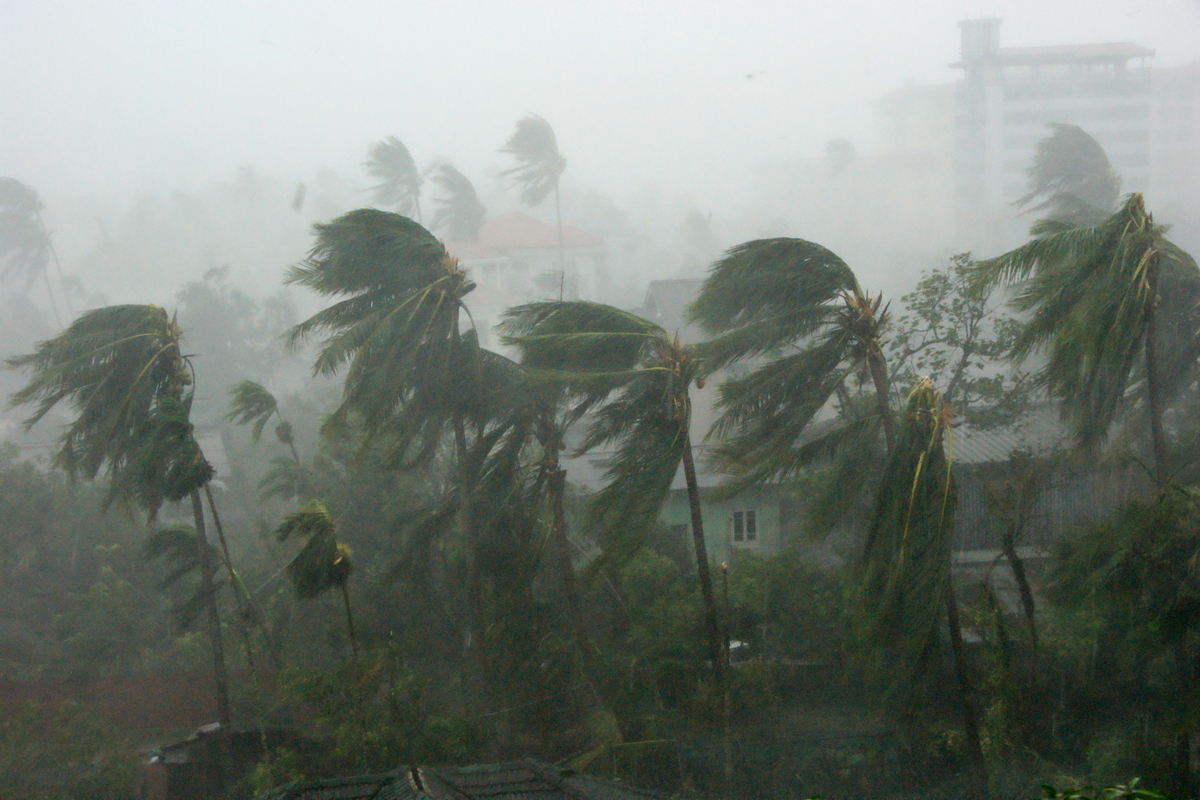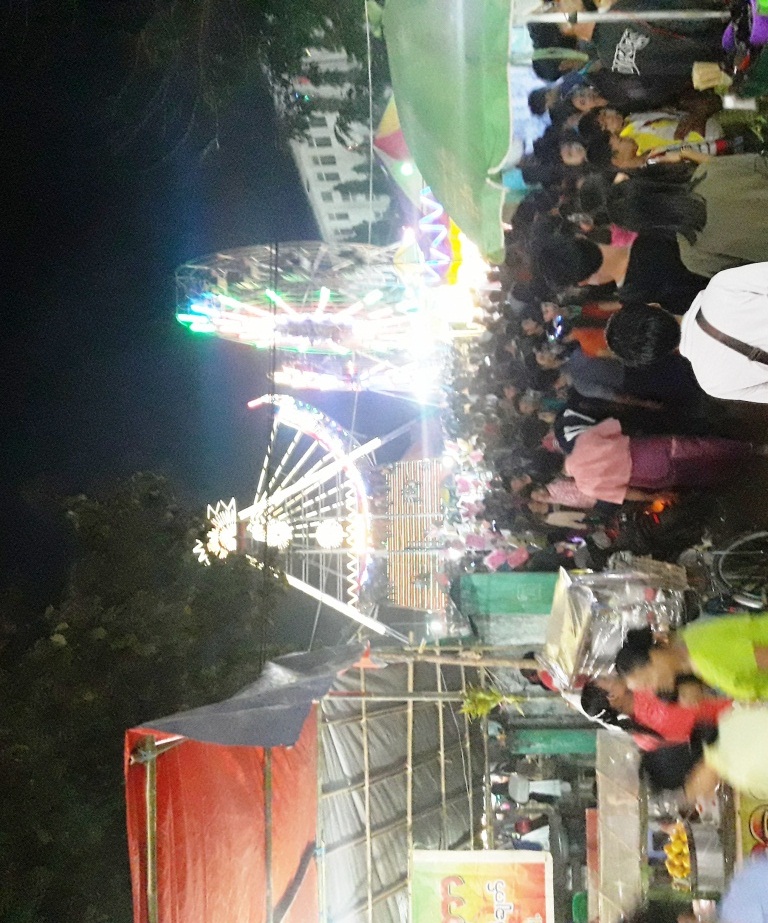|
Kyaikkhauk Pagoda
Kyaukkhauk Pagoda ( my, ကျိုက်ခေါက်စေတီတော်) is a Buddhist pagoda located in Thanlyin Township, in southern Yangon Region, Myanmar. It is a popular tourist destination and also pilgrimage site for Buddhists. It is believed that the pagoda was built on Hlaingpotkon Hill about 2000 years ago by King Sulathrima of Thaton. There are four stairways and the pagoda resembles a Mon-style stupa. A pagoda festival is held annually in February (the 1st waxing to full moon of the Burmese month of Tabodwe) of each year. During Cyclone Nargis Extremely Severe Cyclonic Storm Nargis ( my, နာဂစ်, ur, نرگس ) was an extremely destructive and deadly tropical cyclone that caused the worst natural disaster in the recorded history of Myanmar during early May 2008. The cyclone m ..., the pagoda, which was located on higher elevation, served as a storm shelter for local villagers. 008 Kyaik-khauk, Thanlyin (8729522603).jpg 020 Kyaik-khauk, Thanlyin ... [...More Info...] [...Related Items...] OR: [Wikipedia] [Google] [Baidu] |
Thanlyin Township
Thanlyin (; or ; mnw, သေၚ်, ; formerly Syriam) is a major port city of Myanmar, located across Bago River from the city of Yangon. Thanlyin Township comprises 17 quarters and 28 village tracts. It is home to the largest port in the country, Thilawa port. History Thanlyin first came to prominence in the 15th century as the main port city of the Hanthawaddy Kingdom, replacing a silted up Bago port. In 1539, the city became part of the Kingdom of Taungoo. In 1599, the city fell to the Rakhine forces led by the Portuguese mercenary Filipe de Brito e Nicote, who was made governor of the city. De Brito declared independence from his nominal Rakhine masters in 1603, defeated the invading Rakhine navy in 1604 and 1605, and successfully established Portuguese rule over Syriam or Sirião -as it was called back then- under the Portuguese viceroy of Goa. In 1613, Burmese king Anaukpetlun recaptured the city, and executed Brito by impalement, a punishment reserved for defilers of ... [...More Info...] [...Related Items...] OR: [Wikipedia] [Google] [Baidu] |
Stupa
A stupa ( sa, स्तूप, lit=heap, ) is a mound-like or hemispherical structure containing relics (such as ''śarīra'' – typically the remains of Buddhist monks or nuns) that is used as a place of meditation. In Buddhism, circumambulation or ''pradakhshina'' has been an important ritual and devotional practice since the earliest times, and stupas always have a ''pradakhshina'' path around them. The original South Asian form is a large solid dome above a tholobate or drum with vertical sides, which usually sits on a square base. There is no access to the inside of the structure. In large stupas there may be walkways for circumambulation on top of the base as well as on the ground below it. Large stupas have or had ''vedikā'' railings outside the path around the base, often highly decorated with sculpture, especially at the torana gateways, of which there are usually four. At the top of the dome is a thin vertical element, with one of more horizontal discs spreadin ... [...More Info...] [...Related Items...] OR: [Wikipedia] [Google] [Baidu] |
Buddhist Temples In Yangon
Buddhism ( , ), also known as Buddha Dharma and Dharmavinaya (), is an Indian religion or philosophical tradition based on teachings attributed to the Buddha. It originated in northern India as a -movement in the 5th century BCE, and gradually spread throughout much of Asia via the Silk Road. It is the world's fourth-largest religion, with over 520 million followers (Buddhists) who comprise seven percent of the global population. The Buddha taught the Middle Way, a path of spiritual development that avoids both extreme asceticism and hedonism. It aims at liberation from clinging and craving to things which are impermanent (), incapable of satisfying ('), and without a lasting essence (), ending the cycle of death and rebirth (). A summary of this path is expressed in the Noble Eightfold Path, a training of the mind with observance of Buddhist ethics and meditation. Other widely observed practices include: monasticism; "taking refuge" in the Buddha, the , and the ; and ... [...More Info...] [...Related Items...] OR: [Wikipedia] [Google] [Baidu] |
Pagodas In Myanmar
Burmese pagodas are stupas that typically house Buddhist relics, including relics associated with Buddha. Pagodas feature prominently in Myanmar's landscape, earning the country the moniker "land of pagodas." According to 2016 statistics compiled by the State Sangha Maha Nayaka Committee, Myanmar is home to 1,479 pagodas exceeding in height, a quarter of which are located in Sagaing Region. Several cities in the country, including Mandalay and Bagan, are known for their abundance of pagodas. Pagodas are the site of seasonal pagoda festivals. Burmese pagodas are enclosed in a compound known as the ''aran'' (အာရာမ်, from Pali ''ārāma''), with gateways called ''mok'' (မုခ်, from Pali ''mukha'') at the four cardinal directions. The platform surrounding a Burmese pagoda is called a ''yinbyin'' (ရင်ပြင်). Terms In the Burmese language, pagodas are known by a number of various terms. The umbrella term ''phaya'' (, pronounced ), which derives ... [...More Info...] [...Related Items...] OR: [Wikipedia] [Google] [Baidu] |
Buddhist Pilgrimage Sites In Myanmar
Buddhism ( , ), also known as Buddha Dharma and Dharmavinaya (), is an Indian religions, Indian religion or Indian philosophy#Buddhist philosophy, philosophical tradition based on Pre-sectarian Buddhism, teachings attributed to the Buddha. It originated in History of India, northern India as a -movement in the 5th century BCE, and Silk Road transmission of Buddhism, gradually spread throughout much of Asia via the Silk Road. It is the Major religious groups, world's fourth-largest religion, with over 520 million followers (Buddhists) who comprise seven percent of the global population. The Buddha taught the Middle Way, a path of spiritual development that avoids both extreme asceticism and hedonism. It aims at liberation from clinging and craving to things which are impermanent (), incapable of satisfying ('), and without a lasting essence (), ending the cycle of death and rebirth (). A summary of this path is expressed in the Noble Eightfold Path, a Bhavana, training of t ... [...More Info...] [...Related Items...] OR: [Wikipedia] [Google] [Baidu] |
Cyclone Nargis
Extremely Severe Cyclonic Storm Nargis ( my, နာဂစ်, ur, نرگس ) was an extremely destructive and deadly tropical cyclone that caused the worst natural disaster in the recorded history of Myanmar during early May 2008. The cyclone made landfall in Myanmar on Friday, 2 May 2008, sending a storm surge 40 kilometres up the densely populated Irrawaddy delta, causing catastrophic destruction and at least 138,373 fatalities. The Labutta Township alone was reported to have 80,000 dead, with about 10,000 more deaths in Bogale. There were around 55,000 people missing and many other deaths were found in other towns and areas, although the Myanmar government's official death toll may have been under-reported, and there have been allegations that government officials stopped updating the death toll after 138,000 to minimise political fallout. The feared 'second wave' of fatalities from disease and lack of relief efforts never materialised. Damage was at $12 billion, making Nargi ... [...More Info...] [...Related Items...] OR: [Wikipedia] [Google] [Baidu] |
Tabodwe
Tabodwe ( my, တပို့တွဲ) is the eleventh month of the traditional Burmese calendar. Festivals and observances *Full moon of Tabodwe **Harvest Festival () **Mon National Day Rakhine tug of war festival, Yatha Hswe Pwe. *Pagoda festivals **Alaungdaw Kathapa Pagoda Festival (Sagaing Region) **Shwe Settaw Pagoda Festival (Minbu Township, Magwe Region) **Kyaikkhauk Pagoda Festival (Thanlyin Township, Yangon Region) Tabodwe symbols *Flower: '' Butea monosperma'' References See also *Burmese calendar *Festivals of Burma Burmese traditional festivals are based on the traditional Burmese calendar and dates are largely determined by the moon's phase. Burmese culture is most evident in villages where local festivals are held throughout the year, the most importan ... {{Burmese months Months of the Burmese calendar ... [...More Info...] [...Related Items...] OR: [Wikipedia] [Google] [Baidu] |
Pagoda Festival
Pagoda festivals ( my, ဘုရားပွဲ; ''paya pwe'') are regular festivals found throughout Burma (Myanmar) that commemorate major religious events in pagoda's history, including the founding of a pagoda and the crowning of the pagoda's hti (umbrella). Pagoda festivals are dictated by the Burmese religious calendar and often are held several days at a time. Major events in a pagoda festival typically do not coincide with Uposatha (Buddhist Sabbath) days, during which pious Buddhists observe the Eight Precepts. The majority of pagoda festivals are held during the dry season, from the months of Tazaungmon (November) to Tabaung (March). During the full moon day of Tabaung (Magha Puja), Buddhist devotees in various parts of Myanmar also celebrate sand pagoda festivals. More well-known pagoda festivals often attract numerous pilgrims from throughout the country. Pagoda festivals are similar in nature to agricultural shows (country fairs) or carnivals, and form a signifi ... [...More Info...] [...Related Items...] OR: [Wikipedia] [Google] [Baidu] |
Mon People
The Mon ( mnw, ဂကူမည်; my, မွန်လူမျိုး, ; th, มอญ, ) are an ethnic group who inhabit Lower Myanmar's Mon State, Kayin State, Kayah State, Tanintharyi Region, Bago Region, the Irrawaddy Delta, and several areas in Thailand (mostly in Pathum Thani province, Phra Pradaeng and Nong Ya Plong). There are also small numbers of Mon people in West Garo Hills, calling themselves Man or Mann, who also came from Myanmar to Assam, ultimately residing in Garo Hills. The native language is Mon, which belongs to the Monic branch of the Mon-Khmer language family and shares a common origin with the Nyah Kur language, which is spoken by the people of the same name that live in Northeastern Thailand. A number of languages in Mainland Southeast Asia are influenced by the Mon language, which is also in turn influenced by those languages. The Mon were one of the earliest to reside in Southeast Asia, and were responsible for the spread of Theravada Bu ... [...More Info...] [...Related Items...] OR: [Wikipedia] [Google] [Baidu] |
Myanmar
Myanmar, ; UK pronunciations: US pronunciations incl. . Note: Wikipedia's IPA conventions require indicating /r/ even in British English although only some British English speakers pronounce r at the end of syllables. As John C. Wells, John Wells explains, the English spellings of both Myanmar and Burma assume a non-rhotic variety of English, in which the letter r before a consonant or finally serves merely to indicate a long vowel: [ˈmjænmɑː, ˈbɜːmə]. So the pronunciation of the last syllable of Myanmar as [mɑːr] or of Burma as [bɜːrmə] by some speakers in the UK and most speakers in North America is in fact a spelling pronunciation based on a misunderstanding of non-rhotic spelling conventions. The final ''r'' in ''Myanmar'' was not intended for pronunciation and is there to ensure that the final a is pronounced with the broad a, broad ''ah'' () in "father". If the Burmese name my, မြန်မာ, label=none were spelled "Myanma" in English, this would b ... [...More Info...] [...Related Items...] OR: [Wikipedia] [Google] [Baidu] |
Thaton
Thaton (; mnw, သဓီု ) is a town in Mon State, in southern Myanmar on the Tenasserim plains. Thaton lies along the National Highway 8 and is also connected by the National Road 85. It is 230 km south east of Yangon and 70 km north of Mawlamyine. Thaton was the capital of Thaton Kingdom from at least the 4th century BC to the middle of the 11th century AD. Etymology Thaton is the Burmese name of Sadhuim (သဓီု) in Mon, which in turn is from Sudhammapura () in Pali, after Sudharma, the moot hall of the gods. History Thaton was the capital of the Thaton Kingdom, a Mon Kingdom which ruled present day Lower Burma between the 4th and 11th centuries. Like the Burmans and the Thais, some modern Mons have tried to identify their ethnicity and, specifically this kingdom at Thaton, with the semi-historical kingdom of Suwarnabhumi ("The Golden Land"); today, this claim is contested by many different ethnicities in south-east Asia, and contradicted by scholars ... [...More Info...] [...Related Items...] OR: [Wikipedia] [Google] [Baidu] |
Yangon Region
Yangon Region(, ; formerly Rangoon Division and Yangon Division) is an administrative region of Myanmar. Located in the heart of Lower Myanmar, the division is bordered by Bago Region to the north and east, the Gulf of Martaban to the south, and Ayeyarwady Region to the west. Yangon Region is dominated by its capital city of Yangon, the former national capital and the largest city in the country. Other important cities are Thanlyin and Twante. The division is the most developed region of the country and the main international gateway. The division measures . History The region was historically populated by the Mon. Politically, the area was controlled by Mon kingdoms prior to 1057, and after 1057, with few exceptions, by Burman kingdoms from the north. The control of the region reverted to Pegu-based Mon kingdoms in the 13th to 16th centuries (1287–1539) and briefly in the 18th century (1740–57). The Portuguese were in control of Thanlyin (Syriam) and the surrounding ... [...More Info...] [...Related Items...] OR: [Wikipedia] [Google] [Baidu] |




